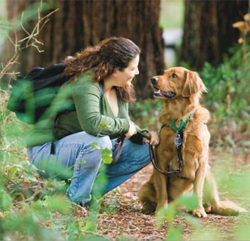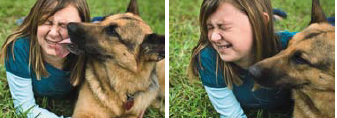
Grayson and her dog Cody.
No one knows for sure how they do it, but it is known that dogs do have the ability to detect low blood sugar levels and this ability has saved countless lives. Devin Grayson had struggled with her diabetes for over 20 years. Grayson restricted her activities and gave up her love for hiking because she was afraid of hypoglycemic episodes. She even moved in with friends because she was afraid to live alone.
One evening, she met true love on the Internet. While surfing the net, she discovered Dogs for Diabetics (D4D), a Concord, California-based organization that provides dogs at no cost to insulin-dependent diabetics. After six months of training, Devin was teamed with a male Golden Retriever named Cody.
As guide dogs guide the blind, and hearing assistance dogs "hear" for the hearing impaired, Cody is the new trend of guide dogs which are trained to identify the onset of hypoglycemia in people with insulin-dependent diabetes. It seems to be a game for the dogs as they work for treats and positive reinforcement; but for their owners, the results are nothing short of miraculous. "We believe that dogs are picking up on scents that are created by chemical changes going on in the person's body before we humans see the actual symptoms of the illness," says Darlene Sullivan, Executive Director of Canine Partners for Life. Trainers say that the canines are right 90% of the time and that they have the ability to sense a dangerous drop in blood glucose before the drop occurs.
Once, a co-worker at Devin's office told her that Cody had been anxiously pawing her knee. Concerned, Devin went to get her glucose monitor. When she checked the woman, her blood glucose was 180. The woman was later diagnosed with type 2 diabetes.
The idea for D4D came from a Forensic Scientist who has type 1 diabetes. Mark Ruefenacht had trained dogs for law enforcement and was working as a volunteer "puppy raiser" for Guide Dogs for the Blind in Northern California. While on a business trip, Mark ate a chocolate doughnut and took extra insulin to compensate but did not check his blood glucose. He happened to have Benton with him, a puppy he was training to be a guide dog. Benton recognized that Mark's blood glucose had plunged and frantically tried to awaken him. "He had difficulty getting me up, and getting me going. But he stayed with me until I got up and ate something to raise my blood sugar," Mark says. "This was not a dog that knew me, or my diabetes. I starting thinking, 'Can I train a dog to do this'?

"The first time the dog gets you up in the middle of the night because your child is dropping into a serious low, rapidly," says Donna Cope of Miami, "you realize it's worth every penny you spent and every minute you had to wait." Her daughter, Hunter, has had diabetes since she was 7 years old. Hunter's German Shepherd Diva, was trained by All Purpose Canines and was placed with the Copes last year. "This dog is incredible," says Donna. "She'll come running to us in the middle of the night with the test kit in her mouth."
As Devin is talking about Cody, the dog comes up and begins licking her hand and pacing. Devin reaches for her glucose monitor and tests. "It's 211," she says. She then pops a piece of dried liver in Cody's mouth and gets out her insulin. "In the past, I wouldn't have checked for another few hours." Cody is on the job.